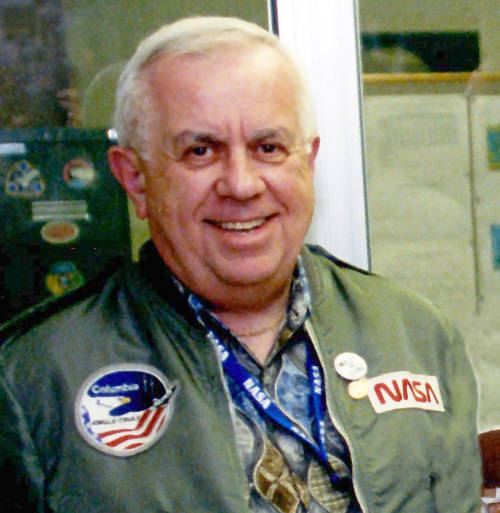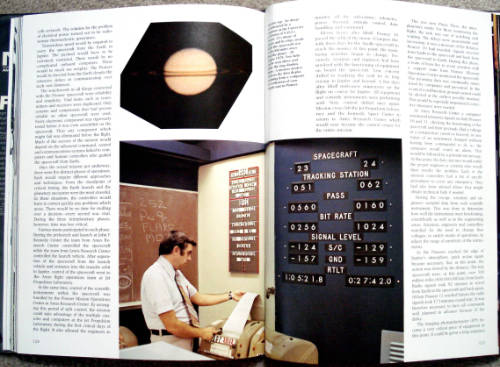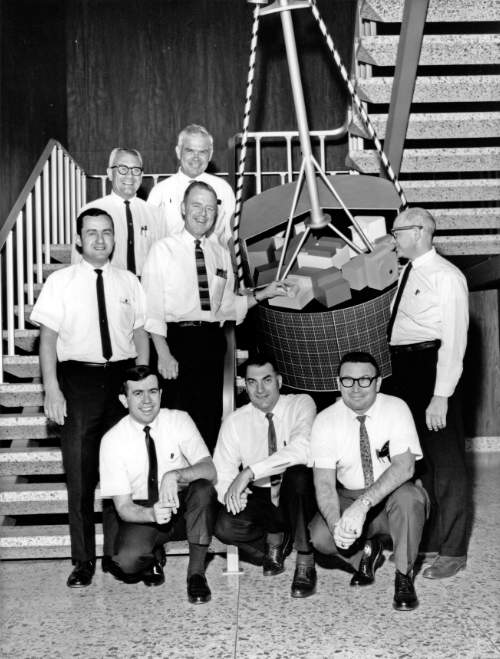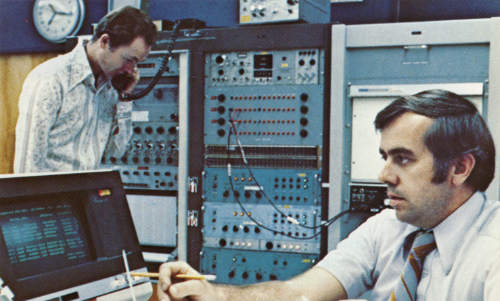David Lozier – Ames Research Center
David Lozier, Ames Research Center: “I had the great fortune to be part of the Golden Age of Space Exploration”. |
Dave Lozier shares the story of his space tracking career at Ames Research Center – Home of the Pioneer missions.
He writes –
“Marci Smith came into the office one day and said ‘you’re in the history books’. I asked, ‘what do you mean’?
She said she was in a bookstore and found this book in the marked down clearance section. It was a commercial publication from England. History of NASA, and in one section there were pictures and a discussion of the Pioneer 10/11 missions. For some unknown reason they had selected a photograph of me looking at some printout from a teletype. …
David Lozier, “In the history books”! |
Most of my interest in science came from science fiction magazines, DC comics and the Flash Gordon early TV serials when I was in grade school. I watched Mr. Wizard, Don Herbert on our grainy black and white TV during the 50s. Oh how I wanted to be that young boy he demonstrated the experiments to on the program.
I was a freshman at Lewis and Clark High School in Spokane Washington on October 4, 1957 the day that the Soviet Union launched Sputnik. Sputnik thrust the nation into the ‘space age’ and the nation responded.
My mother had read some of the Collier’s articles. She hauled me out of bed in the middle of that cold 1957 October night, took me out in the backyard, and told me to stare up at the heavens. Amongst all the stationary stars there was a little point of light moving across the sky from one horizon to the other. Sputnik, man’s first artificial satellite, was reflecting the light from the sun as it traveled in its 90 minute orbit around the Earth. My mother pointed up at the moving light and said ‘Look, this is your future.’ All I remember was the desire to go back to bed.
I majored in Mathematics/Computer Science and towards the end of 1965 I was completing my studies at WSU and since I wasn’t going on to graduate school I knew I would soon need to find a job. The WSU placement office gave me a list of the companies that would be interviewing around this time and one of them was NASA.
I signed up and that’s how I met Don Shilling from the Ames personnel division. Don was interviewing for electrical engineering positions but after he heard I was a programmer he asked me to fill out a SF-57 application for Federal employment and send it back to him anyway. There might be openings since computer science was just starting to be the cutting edge technology field. I really didn’t have any desire to go to California. I didn’t know anyone there and working for the Federal government wasn’t the most desirable thing but I took the form anyway and after I got back to my dorm room, tossed it on my desk.
Later in November I got a call from Don and he was wondering where that application was. I told him I still had it but never filled it out and he said ‘please’ complete it and send it right away. The idea of working for NASA was seductive so I did. So I quickly and not too carefully filled it out and sent it to Ames. It was Christmas vacation and I was home at my parents when a call came in from Ames. It was Bob Hofstetter from the Pioneer Project. They had launched Pioneer 6 on December 16 but they still needed a computer programmer to debug and finish their trajectory codes. They were planning additional Pioneer launches and he asked ‘How would you like to go to work for us?’ I said it sounds great. Bob said they would send an offer and he hung up. What the hell was a ‘trajectory?’
Well the short history is that I filled out the SF-57, sent it in, received an offer, accepted the offer, packed up my bags and went to California. When I arrived in Mountain View, California there was a massive thunderstorm with rain and wind that greeted me. I wasn’t sure I was really in California. It never rained in California, did it?
On February 7, 1966 I became a civil servant in the Pioneer Project working for NASA at Ames Research Center, Moffett Field, California.
For the next 38 years I had the great fortune to be part of the Golden Age of Space Exploration. We sent four spacecraft around the Sun, two to Jupiter and Saturn, a Venus orbiter that lasted 14 years and four probes into the atmosphere of Venus. Lunar Prospector was my last mission before I retired.…”
– Read all of David’s fascinating story in this PDF file which he has kindly assembled. (16MB PDF file.)
Click the image for a 16MB PDF file. |
David’s input has also been incorporated into Hamish Lindsay’s essay on Pioneers 6, 7, 8, 9, E – and we plan to do the same for the section on Pioneers 10 and 11!
The Pioneer 9 launch crew, circa 1968. David is kneeling at left. Ames Research Center photo A-41559. Scan: David Lozier. |
David writes, “This is 1973 and both PN-10/11 are in flight. That picture and three others were a set of four taken for a Pioneer press release. That picture in SP-446 was the GDS, JPL data lines, telemetry CRT, and fan folded printout of more engineering telemetry. That’s John Ragle our GDS engineer.” Photo from page 71 of NASA publication SP-446, Pioneer, First to Jupiter, Saturn, and Beyond. Published 1980. This copy preserved by Hamish Lindsay. |
 |
The “FAB 50” at Ames Research Center in 1972. Photo with thanks to David Lozier. Click the image for a PDF file with names. |
Here is the photo without names. |





